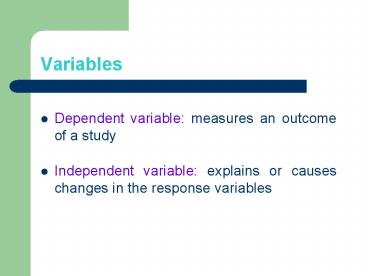Variables PowerPoint PPT Presentation
1 / 13
Title: Variables
1
Variables
- Dependent variable measures an outcome of a
study - Independent variable explains or causes changes
in the response variables
2
Bivariate Data
- We often make two observations on each subject.
We call such data bivariate data. - Examples
- beliefs on abortion, political preference
- height of a person, weight
- dosage of drug, subjects response
- SAT score, first year college GPA
3
Case 1 Both variables qualitative
- Cross tabulation table
- Rows represent categories of 1st variable
- Columns represent categories of 2nd variable
- Count the number of observations falling into
each combination of categories
4
Case 2 One qualitative variable, one
quantitative variable
- Side by side presentation of dot plots, box
plots, 5 number summaries - How do the results differ?
5
Case 3 Two quantitative variables
- Plot observed data on a graph
- Horizontal (X) axis, one variable
- Vertical (Y) axis, other variable
6
Scatterplots
- A scatterplot shows the relationship between two
quantitative variables measured on the same
individuals. - If applicable,
- Independent variable placed on horizontal axis
(So, usually labeled as X) - Dependent variable place on vertical axis
(So, usually labeled as Y)
7
Examining a Scatterplot
- Form
- Linear relationships, where the points show a
straight-line pattern - Curved relationships
- Clusters
- Direction
- Positive association
- Negative Association
- Strength
- Determined by how close points in the scatterplot
lie to a simple form such as a line
8
Examining a Scatterplot
- In any graph of data, look for the overall
pattern and for deviations from that pattern. - Two variables are positively associated when
above-average values of one tend to accompany
above-average values of the other and
below-average values also tend to occur together - Two variables are negatively associated when
above-average values of one accompany
below-average values of the other and vice-versa
9
Lets give it a try!
10
Correlation
- Measures the direction and strength of the linear
relationship between 2 quantitative variables. - Positive r suggests large values of X and Y occur
together and that small values of X and Y occur
together - Negative r suggests large values of one variable
tend to occur with small values of the other
variable
11
- r 1 all data on straight line with positive
slope - r -1 all data on straight line with negative
slope - r 0 no linear relationship
- The stronger the linear relationship, the larger
r - Existence of correlation does not imply
cause/effect
12
Correlation Need to Know(s)
- No distinction between independent and dependent
variable - Both variables must be quantitative
- Correlation uses standardized values, so it does
not change when we change the unit of measurement - Measures only the linear relationship
- Correlation is strongly affected by a few
outlying observations, so it should be used with
caution when outliers appear in scatterplots
13
Applet Exploration
- Go to the website
- www.whfreeman.com/ips
- Register as a student
- Make sure to enter instructors email
- kdbrad2_at_uky.edu

